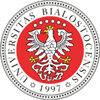Proszę używać tego identyfikatora do cytowań lub wstaw link do tej pozycji:
http://hdl.handle.net/11320/18949| Tytuł: | Outsiderka u Żebrowskich. O Córce Tuśki Gabrieli Zapolskiej |
| Inne tytuły: | An Outsider at the Żebrowskis. On Tuśka’s Daugher by Gabriela Zapolska |
| Autorzy: | Piechota, Dariusz |
| Słowa kluczowe: | rodzina outsider nastolatek mieszczanie Córka Tuśki family outsider teenager bourgeois Tuśka’s Daughter |
| Data wydania: | 2022 |
| Data dodania: | 7-paź-2025 |
| Wydawca: | Collegium Columbinum SJ |
| Źródło: | Zapolska międzynarodowa. Seria I: Biografia, estetyka, recepcja, red. nauk. Anna Janicka i Piotr Biłos, Kraków – Białystok 2022, s. 179-191 |
| Seria: | Przełomy/Pogranicza: Studia Literackie;50 |
| Konferencja: | I Międzynarodowa Konferencja Naukowa „Gabriela Zapolska. Biografia – Estetyka – Idee", Białystok–Paryż–Lwów, 24 września 2021 r. |
| Abstrakt: | The category of outsider in Zapolska’s work refers not only to literary heroines, but also to the author, who rebels against the hypocrisy prevailing in the bourgeois society. This article is devoted to analysing Tuśka’s Daughter, which is an interesting psychological study of a teenager growing up in a philistine family. As a keen observer of the surrounding world, Zapolska thoroughly analyses Pita’s inner life, describing her complicated relations with her parents and siblings. It is worth mentioning that the world in Tuśka’s Daughter is getting darker. In the first volume, there are signs of impending disaster (arms trafficking, bloody repression). There is a growing awareness of danger in society, which is clearly exemplified by Pita’s fears. Zapolska’s novel is dominated by a landscape of destruction; ties are breaking down not only between family members, but also between generations. Using Żebrowski’s family as an example, Zapolska, like a sociologist and psychologist, accurately captured the vague value system of the bourgeoisie, in which she particularly criticised the relationship between parents and children based solely on ossified conventions. Pita would not probably have become an outsider if her parents had paid more attention to her and shown more affection. |
| Afiliacja: | Uniwersytet w Białymstoku |
| Nota biograficzna: | DARIUSZ PIECHOTA – dr nauk humanistycznych, asystent w Katedrze Badań Filologicznych „Wschód – Zachód” w Kolegium Literaturoznawstwa Uniwersytetu w Białymstoku; członek Laboratorium Animal Studies – Trzecia Kultura, nauczyciel języka angielskiego w Zespole Szkół nr 3 im. Marii Dąbrowskiej w Puławach. Autor książek: Między utopią a melancholią. W kręgu nowoczesnej i ponowoczesnej literatury fantastycznej (Lublin 2015); Pozytywistów spotkania z naturą. Szkice ekokrytyczne (Gdańsk 2018). Współredaktor serii Zielona Historia Literatury (Emancypacja zwierząt? (Lublin 2015), Ekomodernizmy (Lublin 2016), Między empatią a okrucieństwem (Gdańsk 2018), (Nie)zapomniane zwierzęta (Gdańsk 2021). W kręgu jego zainteresowań badawczych znajdują się: literatura drugiej połowy XIX wieku, współczesna kultura popularna, animal studies, ekokrytyka oraz nauczanie języka polskiego jako obcego |
| URI: | http://hdl.handle.net/11320/18949 |
| ISBN: | 978-83-7624-204-1 |
| metadata.dc.identifier.orcid: | 0000-0002-7943-384X |
| Typ Dokumentu: | Book chapter |
| Właściciel praw: | © Uniwersytet w Białymstoku, Białystok 2022 © Collegium Columbinum, Kraków 2022 © Anna Janicka i Piotr Biłos, Białystok 2022 |
| Występuje w kolekcji(ach): | I Międzynarodowa Konferencja Naukowa „Gabriela Zapolska. Biografia – Estetyka – Idee", 24 września 2021 Materiały konferencyjne (WFil) |
Pliki w tej pozycji:
| Plik | Opis | Rozmiar | Format | |
|---|---|---|---|---|
| D_Piechota_Outsiderka_u_Zebrowskich.pdf | 208,79 kB | Adobe PDF | Otwórz |
Pozycja jest chroniona prawem autorskim (Copyright © Wszelkie prawa zastrzeżone)

